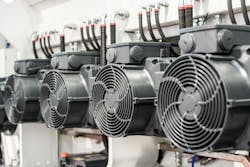Motor starters vs. VFDs: find the right fit for motor control
Key highlights
- Motor starters remain the preferred choice for simple, low-support applications where speed control is not required, such as in agriculture or remote pumping.
- A VFD's ROI is easiest to justify in applications with quadratic torque loads like fans and pumps, where energy savings can provide a payback in just a few months.
- While VFDs offer efficiency, they require careful consideration of panel design, heat management and potential additional components to mitigate issues like harmonics and stress on power lines.
The transition from motor starters to variable-frequency drives (VFDs) continues to reshape industrial motor control, offering new efficiencies while presenting fresh challenges. Craig Nelson, senior product marketing manager at Siemens, shares insights on where motor starters still make sense, how to evaluate the return on investment (ROI) for VFDs and what pitfalls to avoid when selecting the right technology for each application.
Legacy systems and retrofitting
Motor starters are still commonly used in simple, low-support applications such as agriculture, remote pumping and basic batch processes where speed control is unnecessary. Retrofit decisions often hinge on whether a VFD can deliver quick energy payback or process improvements, particularly in fan and pump systems.
Q: Which applications or industries still rely heavily on across-the-line motor starters, and why?
A: Agriculture and simple tasks such as tank filling or batch mixing, where speed control is not needed and maintenance support is generally basic still tend to utilize motor starters.
Q: Are there specific machine types or processes where motor starters are still preferred over VFDs?
A: Machines or equipment that handle basic tasks like pumping and may be utilized remotely with little support or little knowledge about the environment and power supply that will be used tend to pick the more basic approach with motor starters.
Q: How do you decide whether to retrofit an existing motor starter system with a VFD or leave it as is?
A: For quadratic torque applications that use dampers and valves such as fans and pumps where the energy payback time of installing a variable speed drive is sometimes only months, the decision is easy. In other industrial applications, the decision usually comes down to if speed control can make process improvements.
Design considerations: VFD vs. motor starter
When selecting between a motor starter and a VFD, engineers must balance simplicity and lower cost against enhanced functionality and energy efficiency. Considerations such as torque requirements, heat management, panel space and cabling complexity all play critical roles in determining the best solution for a given application.
Q: What are the biggest engineering trade-offs when choosing between a motor starter and a VFD?
A: Simplicity and cost vs. energy efficiency and functionality are the key trade-offs to take into consideration when choosing between a motor starter and a VFD. The engineering advantages of VFDs are typically mechanical with less stress on starts, for example. With motor starters, the advantages are more electrical with lower harmonics and less components.
Q: What power or torque requirements influence the choice between the two?
A: VFDs utilize less starting torque due to ramping. Motor starters provide higher starting torque, but the problem is they supply a high starting torque to every start, not just when needed, as with VFD.
Q: How do VFDs impact panel design, heat management or enclosure size compared to motor starters?
A: A VFD is a power conversion device so more heat is generated in the control cabinet. The same horsepower VFD has a larger footprint than a motor starter, too. Additionally, since a VFD may have control signals and pulse width modulation (PWM) signals on the motor cables, the cabling can be more involved.
Get your subscription to Control Design’s daily newsletter.
Cost and ROI
Evaluating the cost and ROI of switching from motor starters to VFDs depends on factors such as load type, energy prices and regulatory requirements. While VFDs can offer rapid payback and improved efficiency in many applications, small motors with low energy use may not justify the added expense.
Q: What’s the typical ROI timeline when replacing motor starters with VFDs?
A: The payback in power savings of a VFD when applied to quadradic loads, where speed can be matched to the application, can sometimes be as short as a few months. To make a more accurate assumption, the application and load cycle need to be taken into consideration. Many drive vendors offer an ROI tool to help make this calculation.
Q: Have component or installation costs shifted significantly in recent years to make VFDs more accessible?
A: The increasing price of energy and the cost of not being as energy efficient as one can be have really been the biggest shifts in cost. Many regions have directives that require an energy-efficient solution be used.
Q: In which situations is a VFD still considered overkill from a cost-benefit standpoint?
A: In many fractional or small horsepower applications, where the energy used is not significant, a motor starter may be the best solution.
VFD selection: challenges and pitfalls
Selecting VFDs without proper analysis can lead to performance issues, added costs and unnecessary complexity. Understanding the limitations, sizing requirements and additional components needed is essential to avoid pitfalls and ensure the right choice between a VFD and a motor starter.
Q: What common mistakes do you see when VFDs are selected without proper application analysis?
A: Since a VFD is a power conversion device with non-linear characteristics, additional stress considerations to the power line and motor cable should be taken into account. This may require additional components such as line reactor or limitations or total cable length from VFD to motor.
Q: What’s the most misunderstood aspect of selecting or applying VFDs?
A: Users should understand the overload capability of a VFD to be able to right size it for the application. They should also understand the many functions of a VFD to help optimize energy usage and maintain operation such as automatic restart on power failure.
About the Author
Anna Townshend
Managing Editor
Anna Townshend has been a writer and journalist for 20 years. Previously, she was the editor of Marina Dock Age and International Dredging Review, until she joined Endeavor Business Media in June 2020. She is the managing editor of Control Design and Plant Services.


